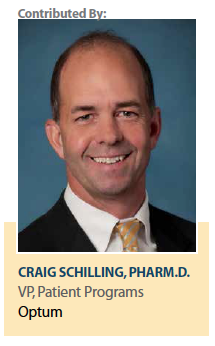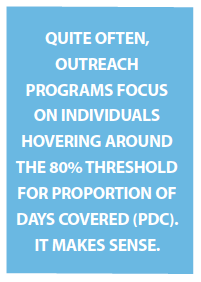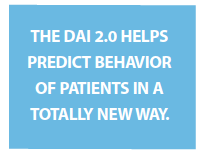 If you’re targeting only the most obvious patients with your medication adherence programs, you’re missing out on a big opportunity. Quite often, outreach programs focus on individuals hovering around the 80% threshold for proportion of days covered (PDC). It makes sense.
If you’re targeting only the most obvious patients with your medication adherence programs, you’re missing out on a big opportunity. Quite often, outreach programs focus on individuals hovering around the 80% threshold for proportion of days covered (PDC). It makes sense.
Why not use your resources to help those just below 80% to become adherent, while at the same time encouraging those just above 80% to stay there?
Surprisingly, we’ve found that this approach omits a significant number of individuals on both sides of the 80% threshold who would benefit from intervention. Meantime, it wastes resources on a large group of people who don’t really need, or won’t benefit from, expensive outreach programs. The key, we determined, was not only to categorize patients by where they end up on the PDC scale, but also to gauge the likelihood that they would go from non-adherence to adherence, or vice versa.
The Volatile 30%
Through our analysis of a 3 million-member Medicare Advantage plan, we found that roughly 30% of the population taking diabetes medications, RAS antagonists and statins shifted each year from adherence to non-adherence or non-adherence to adherence.
Interestingly, these patients were not always those who sat right near the 80% PDC threshold. These insights prompted us to take a closer look at this volatile 30% and identify the common factors that would help explain the reasons for the movement. What we found led to the development of the Optum Drug Adherence Index 2.0.
The DAI 2.0 helps predict the behavior of patients in a totally new way. Through more sophisticated algorithms that consider variables such as past prescription behaviors, medical claims, and sociodemographic data, this new model identifies the segments of the population that are at greatest risk to fall from adherence to non-adherence in the coming 12 months, as well as those that have the greatest propensity to rise to adherence.
Using Real-World Data
 Chart 1 below shows an actual population of Medicare patients taking RAS antagonists in dark blue. As you can see, many in this population have adherence rates of 90% to 100% PDC. Meanwhile, Chart 2 shows a segment of this population in gray. This represents the traditional targets of adherence programs and interventions: those in the 70% to 85% range. The reasoning is that the patients close to the 80% threshold can more easily be positively impacted.
Chart 1 below shows an actual population of Medicare patients taking RAS antagonists in dark blue. As you can see, many in this population have adherence rates of 90% to 100% PDC. Meanwhile, Chart 2 shows a segment of this population in gray. This represents the traditional targets of adherence programs and interventions: those in the 70% to 85% range. The reasoning is that the patients close to the 80% threshold can more easily be positively impacted.
With Chart 3, we see that with the Drug Adherence Index 2.0, the patients who are actually at risk for becoming non-adherent are across the entire population — not just in the 70% to 85% range. In fact, many of the at-risk patients are in the 90% to 100% range. And over on the right-hand side of the graph, there are patients well under the 70% levels who could very likely become more adherent with some help.
More importantly, Chart 4 shows all the patients in what we call the “blind spot," that is, patients who could benefit greatly from proactive outreach and education, but they are not seen in more traditional adherence programs.
In this example, 145,584 patients are at risk for falling below the 80% PDC threshold. But with traditional efforts they would be completely missed. Also, 26,539 patients who might well rise to the 80% threshold with some assistance are also missed. Collectively, this means 172,123 patients or 85% of the total population could have been targeted for assistance but were not. That is a big blind spot and an even bigger missed opportunity.
What This Means for Life Sciences
The DAI 2.0 helps save time and resources for payers by minimizing adherence blind spots. It makes it much easier to zero in on the right patients and match them with the interventions most likely to help them. It also helps avoid the waste in resources that can occur when reaching out to individuals who will not benefit from intervention. But what about drug companies? Payers aren’t the only ones who can benefit. The DAI 2.0 can help you:
patients and match them with the interventions most likely to help them. It also helps avoid the waste in resources that can occur when reaching out to individuals who will not benefit from intervention. But what about drug companies? Payers aren’t the only ones who can benefit. The DAI 2.0 can help you:
Develop better predictive analytics for a specific therapeutic area,
Identify highly differentiated risk profiles for future non-adherence programs,
Segment and stratify patient populations in need of adherence intervention,
Target marketing/education efforts specific to a demographic, or geography associated with adherence findings.(PV)
Optum is a global team of approximately 80,000 people, working collaboratively across the health system to improve care delivery, quality, and cost-effectiveness by focusing on three key drivers of transformative change: engaging the consumer, aligning care delivery, and modernizing the health system infrastructure.
For more information, visit optum.com










